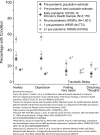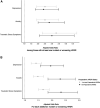Change in Health-Related Socioeconomic Risk Factors and Mental Health During the Early Phase of the COVID-19 Pandemic: A National Survey of U.S. Women
- PMID: 33818123
- PMCID: PMC8064961
- DOI: 10.1089/jwh.2020.8879
Change in Health-Related Socioeconomic Risk Factors and Mental Health During the Early Phase of the COVID-19 Pandemic: A National Survey of U.S. Women
Abstract
Background: During a pandemic, women may be especially vulnerable to secondary health problems driven by its social and economic effects. We examined the relationship between changes in health-related socioeconomic risks (HRSRs) and mental health. Materials and Methods: A cross-sectional survey of 3,200 women aged 18-90 years was conducted in April 2020 using a quota-based sample from a national panel (88% cooperation rate). Patterns of change in HRSRs (food insecurity, housing instability, interpersonal violence, and difficulties with utilities and transportation) were described. Weighted, multivariate logistic regression was used to model the odds of depression, anxiety, and traumatic stress symptoms among those with and without incident or worsening HRSRs. Results: More than 40% of women had one or more prepandemic HRSRs. In the early pandemic phase, 49% of all women, including 29% with no prepandemic HRSRs, had experienced incident or worsening HRSRs. By April 2020, the rates of depression and anxiety were twice that of prepandemic benchmarks (29%); 17% of women had symptoms of traumatic stress. The odds of depression, anxiety, and posttraumatic stress symptoms were two to three times higher among women who reported at least one incident or worsening HRSR; this finding was similar for women with and without prepandemic HRSRs. Conclusions: Increased health-related socioeconomic vulnerability among U.S. women early in the coronavirus disease 2019 (COVID-19) pandemic was prevalent and associated with alarmingly high rates of mental health problems. Pandemic-related mental health needs are likely to be much greater than currently available resources, especially for vulnerable women.
Keywords: COVID-19; disparities; health behaviors; mental health; social determinants of health.
Conflict of interest statement
S.T.L. is founder and co-owner of NowPow, LLC. Neither the University of Chicago nor the University of Chicago Medicine is endorsing or promoting NowPow or its business, products, or services. S.T.L. and her spouse own equity in Glenbervie Health, LLC, and health care-related stocks and mutual funds managed by third parties. E.L. receives research funding from AbbVie and Arsenal Bio to perform translational ovarian cancer research that is completely unrelated to this study. All other authors report no disclosures.
Figures



Similar articles
-
Racial and Ethnic Disparities in Health-Related Socioeconomic Risks During the Early COVID-19 Pandemic: A National Survey of U.S. Women.J Womens Health (Larchmt). 2021 Oct;30(10):1375-1385. doi: 10.1089/jwh.2021.0230. Epub 2021 Sep 16. J Womens Health (Larchmt). 2021. PMID: 34529520 Free PMC article.
-
Unwanted sexual activity among United States women early in the COVID-19 pandemic.Am J Obstet Gynecol. 2023 Feb;228(2):209.e1-209.e16. doi: 10.1016/j.ajog.2022.09.048. Epub 2022 Oct 12. Am J Obstet Gynecol. 2023. PMID: 36241078 Free PMC article.
-
A cross-national study of factors associated with women's perinatal mental health and wellbeing during the COVID-19 pandemic.PLoS One. 2021 Apr 21;16(4):e0249780. doi: 10.1371/journal.pone.0249780. eCollection 2021. PLoS One. 2021. PMID: 33882096 Free PMC article.
-
Mental burden and its risk and protective factors during the early phase of the SARS-CoV-2 pandemic: systematic review and meta-analyses.Global Health. 2021 Mar 29;17(1):34. doi: 10.1186/s12992-021-00670-y. Global Health. 2021. PMID: 33781283 Free PMC article.
-
Psychosocial alterations during the COVID-19 pandemic and the global burden of anxiety and major depressive disorders in adolescents, 1990-2021: challenges in mental health amid socioeconomic disparities.World J Pediatr. 2024 Oct;20(10):1003-1016. doi: 10.1007/s12519-024-00837-8. Epub 2024 Aug 20. World J Pediatr. 2024. PMID: 39162949 Review.
Cited by
-
Interplay between Comorbidities and Long COVID: Challenges and Multidisciplinary Approaches.Biomolecules. 2024 Jul 11;14(7):835. doi: 10.3390/biom14070835. Biomolecules. 2024. PMID: 39062549 Free PMC article. Review.
-
A longitudinal study on impact of emergency cash transfer payments during the COVID pandemic on coping among Australian young adults.Sci Rep. 2024 Aug 12;14(1):17523. doi: 10.1038/s41598-024-68027-0. Sci Rep. 2024. PMID: 39134578 Free PMC article.
-
Turning to Religion During COVID-19 (Part II): A Systematic Review, Meta-analysis and Meta-regression of Studies on the Relationship between Religious Coping and Mental Health throughout COVID-19.J Relig Health. 2023 Feb;62(1):544-584. doi: 10.1007/s10943-022-01720-4. Epub 2023 Jan 3. J Relig Health. 2023. PMID: 36595190 Free PMC article.
-
Systematic review of mental health symptom changes by sex or gender in early-COVID-19 compared to pre-pandemic.Sci Rep. 2022 Jul 6;12(1):11417. doi: 10.1038/s41598-022-14746-1. Sci Rep. 2022. PMID: 35794116 Free PMC article.
-
The COVID-19 pandemic's intersectional impact on work life, home life and wellbeing: an exploratory mixed-methods analysis of Georgia women's experiences during the pandemic.BMC Public Health. 2022 Oct 31;22(1):1988. doi: 10.1186/s12889-022-14285-4. BMC Public Health. 2022. PMID: 36316668 Free PMC article.
References
-
- Wenham C, Smith J, Davies SE, et al. . Women are most affected by pandemics—Lessons from past outbreaks. Nature 2020;583:194–198 - PubMed
-
- Noursi S. COVID-19 and Women's Health. National Institutes of Health: Office of Research on Women's Health. Available at: https://orwh.od.nih.gov/about/director/messages/guest-blog-covid-19-and-... Accessed October1, 2020
Publication types
MeSH terms
Grants and funding
LinkOut - more resources
Full Text Sources
Other Literature Sources
Medical
Miscellaneous

